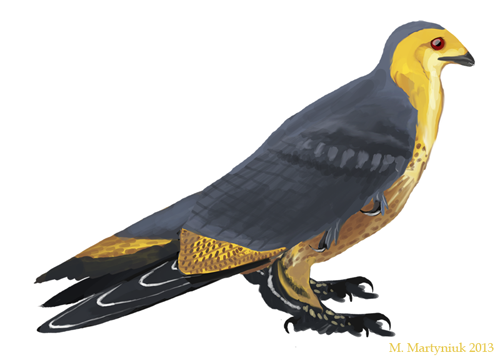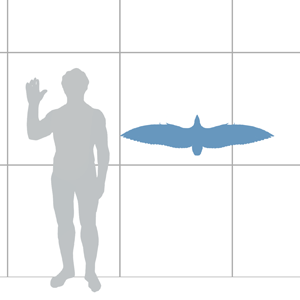home > natural history
Sapeornis chaoyangensis
"Chaoyang Society of Avian Paleontology and Evolution bird"

Sapeornis were very unusual among the other birds of the Jehol biota, and were also among the largest flying birds of the Mesozoic. Their extremely long, narrow, pointed wings suggest that they were adpet at soaring, and comparison with modern birds suggest they were aerial foragers like Buteo. The large talons on both the feed and wings suggest that they were adept perchers and climbers, but their large size andl ong wings imply that, unlike most other Jehol birds, these preferred wide open spaces with room to soar in search of food, rather than cramped forests. They bore long feathers on their lower legs, also reminiscant of modern birds of prey, and appear to have had fully feathered feet as well.
However, these were no predators--the skulls resemble caenagnathiformes with short, high snouts and blunt, forward-pointing teeth suitible for eating fruits, seeds, and foliage. Numerous species of similar birds have been named, but there is no evidence to suggest these are not all variatons and growth stages of he single species Sapeornis chaoyangensis.
Image License:
ALL RIGHTS RESERVED
DESCRIPTION
Length: 50cm (1ft 8in)
Wingspan: 1.4m (4.6ft)
Location: Jiufotang Formation, Liaoning, China
Time: Aptian age, Early Cretaceous, (120 Ma)
CLASSIFICATION
Kingdom: Animalia
Phylum: Chordata
Class: Stem-Aves
Family: Omnivoropterygidae
Genus: Sapeornis
Species: S. chaoyangensis
SYSTEMATICS
Sauropsida
Diapsida
Archosauria
Ornithosuchia
Dinosauria
Theropoda
Coelurosauria
Maniraptora
Avialae
Pygostylia
